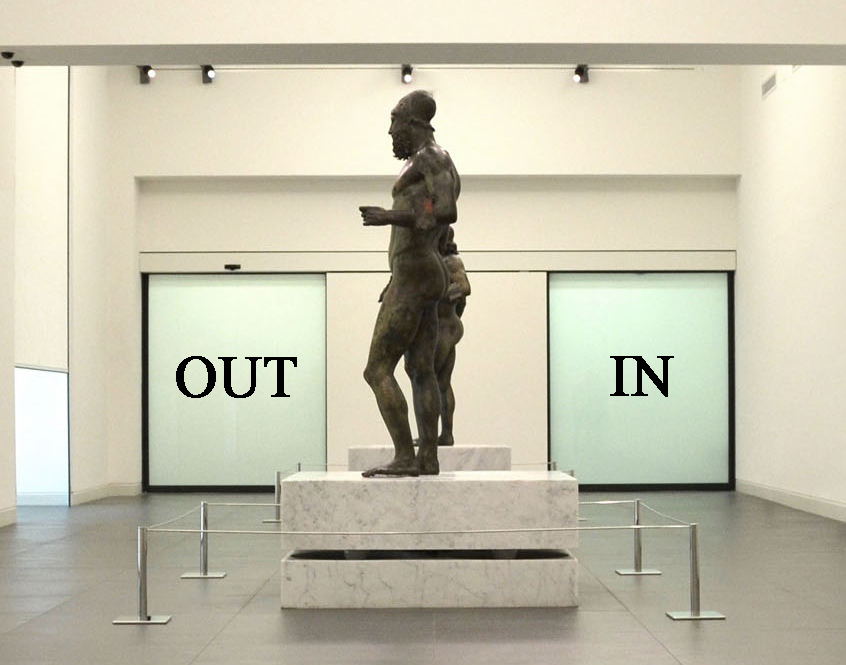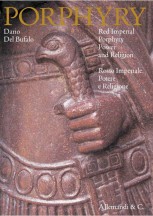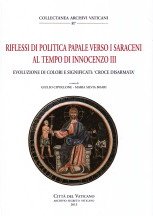Prof. Dario Del Bufalo
Specialist in stone sculpture , colored marbles , glyptics , restoration and Geoarchaeology
“BUFALE ARCHEOLOGICHE” Column in Il Giornale dell’Arte – October 2014
I was decontaminated for those back-sides
 To entice the (Italian) public to visit museums thousands of strategies are adopted, including opening on public holidays and night openings or free entries several times a year: it is called «valorization», which should not prevent «conservation». But when does conservation prevent valorization? To visit the Riace Bronzes this summer, I was subjected to a humiliating decontamination, first in a «buffer-room» for 20 minutes, during which one can watch a generic introductory video about the two masterpieces and the lost wax casting technique, then in a second «buffer room» for a further 3 minutes. Luckily (as usual) there was no one in this «extractor room», which would host up to 20 people at one time; there were only three of us, with two chairs. The ticket, costing 5 euros, allows you to visit just the Bronzes, the rest of the museum (the National Archaeological Museum of Reggio Calabria) is closed for an incredibly expensive and endless rehanging (33 million euro). The curious and amusing fact is that you get decontaminated at the exit as well, almost as if to remove that small amount of artistic genius that was deposited on you in the museum. It does not seem an incentive for lazy and fleeting museum visitors, or the best way to valorize the museum. I understand that special attention is given to the Arena Chapel in Padua, where the «breathing» Giotto frescoes fear humidity changes, as does the Sistine Chapel or the Last Supper. On the contrary nothing is done for the hundreds of small museums which house delicate paintings on wood, gilt grounds and frescoes that suffer equally if not more; bronze is a copper and tin alloy that goes back to ancient times, precisely why we have the Bronze Age, the period in which this metal was the hardest, most lasting and most durable. The poet Horace speaking of his Odes, used bronze as a benchmark for durability, stating that his tales will be more long-lived than bronze, Aere perennius. In fact, the equestrian statue of Marcus Aurelius in Rome, the Colossus of Barletta and the Horses of Venice, exposed to sun, wind and rain for 2 thousand years, are in good condition. I agree that the Bronzes are now conserved in a museum and are in retirement to be taken care of. This does not mean that the visitor has to be treated like a pandemic leper, perhaps to then put the two masterpieces in front of some worthless photographer to portray them dressed up as Crazy Horse dancers. In all museums worldwide, archaeological bronzes, colossal or not, are not kept in hyperbaric or hygroscopic chambers. The Getty Museum in Los Angeles exhibits the Statue of the Victorious Youth (that comes, like the Riace Bronzes, from our seas) without all this alchemic attention, in the same manner as the Metropolitan, the Louvre and the British Museum with their bronzes. The best thing about this new and expensive way the works are exhibited in Reggio Calabria is that the visitor enters the room of Bronzes and immediately admires the two heroes’ eternally firm backsides, for which Italians are now universally made fun of.
To entice the (Italian) public to visit museums thousands of strategies are adopted, including opening on public holidays and night openings or free entries several times a year: it is called «valorization», which should not prevent «conservation». But when does conservation prevent valorization? To visit the Riace Bronzes this summer, I was subjected to a humiliating decontamination, first in a «buffer-room» for 20 minutes, during which one can watch a generic introductory video about the two masterpieces and the lost wax casting technique, then in a second «buffer room» for a further 3 minutes. Luckily (as usual) there was no one in this «extractor room», which would host up to 20 people at one time; there were only three of us, with two chairs. The ticket, costing 5 euros, allows you to visit just the Bronzes, the rest of the museum (the National Archaeological Museum of Reggio Calabria) is closed for an incredibly expensive and endless rehanging (33 million euro). The curious and amusing fact is that you get decontaminated at the exit as well, almost as if to remove that small amount of artistic genius that was deposited on you in the museum. It does not seem an incentive for lazy and fleeting museum visitors, or the best way to valorize the museum. I understand that special attention is given to the Arena Chapel in Padua, where the «breathing» Giotto frescoes fear humidity changes, as does the Sistine Chapel or the Last Supper. On the contrary nothing is done for the hundreds of small museums which house delicate paintings on wood, gilt grounds and frescoes that suffer equally if not more; bronze is a copper and tin alloy that goes back to ancient times, precisely why we have the Bronze Age, the period in which this metal was the hardest, most lasting and most durable. The poet Horace speaking of his Odes, used bronze as a benchmark for durability, stating that his tales will be more long-lived than bronze, Aere perennius. In fact, the equestrian statue of Marcus Aurelius in Rome, the Colossus of Barletta and the Horses of Venice, exposed to sun, wind and rain for 2 thousand years, are in good condition. I agree that the Bronzes are now conserved in a museum and are in retirement to be taken care of. This does not mean that the visitor has to be treated like a pandemic leper, perhaps to then put the two masterpieces in front of some worthless photographer to portray them dressed up as Crazy Horse dancers. In all museums worldwide, archaeological bronzes, colossal or not, are not kept in hyperbaric or hygroscopic chambers. The Getty Museum in Los Angeles exhibits the Statue of the Victorious Youth (that comes, like the Riace Bronzes, from our seas) without all this alchemic attention, in the same manner as the Metropolitan, the Louvre and the British Museum with their bronzes. The best thing about this new and expensive way the works are exhibited in Reggio Calabria is that the visitor enters the room of Bronzes and immediately admires the two heroes’ eternally firm backsides, for which Italians are now universally made fun of.
For info or to report something: bufalearcheologiche@gmail.com
Read all the ARCHEO SPOOF STORIES
 English
English Italiano
Italiano
